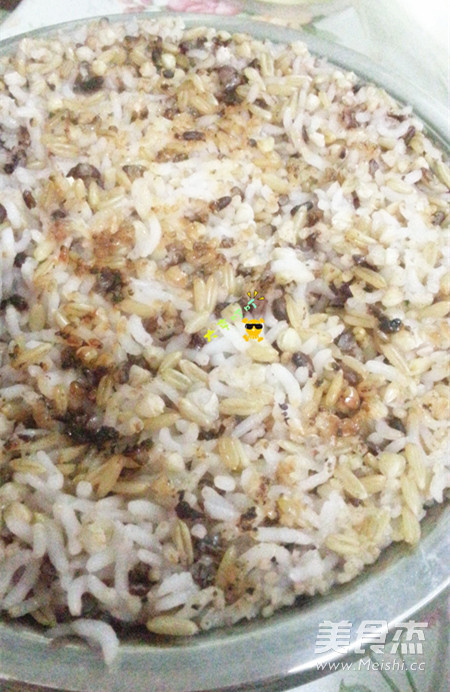Five-color Multigrain Rice
1.
First take a stainless steel basin with an inner diameter of 16cm. Clockwise, put oatmeal rice first, then millet, then buckwheat rice, and finally black glutinous rice. If there are many people in the family, you can change to a larger pot, and the amount can be gradually increased.
2.
Finally, evenly cover the rice. Then rub it with your hands evenly. There are five kinds of rice in a handful.
3.
After washing twice with water, pour an appropriate amount of warm water and soak for 10 minutes.
4.
After the soaked water is poured out, put in cold water again, the more ice the better.
5.
Put the pot on high heat and steam for 10 minutes. Turn off the heat and steam for 5 minutes. Finally, turn off the heat and simmer for 5 minutes without opening the lid.
6.
The five-color multigrain rice is steamed, you can enjoy it...


Tips:
According to the theory of the five elements (wood, fire, earth, gold, water) in the theory of health preservation in traditional Chinese medicine, the five flavors of nature (acid, bitter, sweet, pungent, salty), five colors (green, red, yellow, white, black) and many The attributes of things. Explain the connection between man and nature. Humans live between heaven and earth. The natural environment is an integral part of the entire material world. It should be integrated with nature. Plants in nature are colorful and grow under the nourishment of sunlight and rain, providing food for the soul of all things. source. The five internal organs of the human body are closely related to the five colors of nature.
Oatmeal: It is recognized as one of the grains with high nutritional value in the world. Its nutritional value is very high. Its fat content is 4 times that of rice. The content of 8 amino acids and vitamin E required by the human body is also higher than that of rice and white noodles. Nutritionists have discovered that oatmeal is also an ideal food to prevent atherosclerosis, high blood pressure, and coronary heart disease. It is rich in sulfinic acid, which accounts for 35%-52% of all unsaturated fatty acids. It has auxiliary effects on diabetes, fatty liver, constipation, edema, etc. It is beneficial for middle-aged and elderly people to increase physical strength and prolong life. Oatmeal contains a kind of oat extract, which has the unique aroma of cereals. Oatmeal has been used as medicine since ancient times. It is sweet in nature and warm in taste, and has the functions of replenishing the spleen, stomach, smooth intestines, inducing labor, stopping sweating and bleeding. Oatmeal noodle soup is a dietary supplement for lying-in women, infants, patients with chronic diseases, and the infirm after illness. Oatmeal contains less sugar, more protein, and high fiber. It is an ideal health care product for patients with cardiovascular disease and diabetes.
Xiaomi: also known as yellow rice. Sweet in taste and slightly cold in nature; It has the effects of replenishing yin, lungs, and large intestine; it can treat yang and yin deficiency, sleepless at night, long-time venting weak stomach, and treat frostbite, scabies, toxic fever, swelling and other symptoms.
Buckwheat rice: also known as triangle wheat, rye wheat, and buckwheat. There are mainly two kinds of buckwheat cultivated in our country: ordinary buckwheat and tartary buckwheat. The former is called sweet buckwheat and the latter is called tartary buckwheat. Because the seeds of tartary buckwheat contain rutin, it is also called tartary buckwheat. Buckwheat has a long history of cultivation in our country. There is a record in the "Book of Shennong" in the fifth century BC that buckwheat was one of the eight cultivated grains at that time. In addition to our country, the former Soviet Union, Nepal, North Korea, Japan, and some people in America and Europe In some areas, people also like to eat buckwheat. Especially in Japan, since buckwheat was introduced from my country from the Tang Dynasty, buckwheat food has been popular in the Japanese islands, and there are more than 100 ways to eat it. So far, Japan still classifies buckwheat food as a health food. Buckwheat rice is the seed with or without the seed coat obtained by removing the shell of the buckwheat fruit.
Black glutinous rice: Purple rice is a variety of rice, which belongs to the glutinous rice category. It is only cultivated in a small amount in Sichuan, Guizhou, and Yunnan. It is a more precious rice variety, divided into two types: purple japonica and purple glutinous rice. The purple rice has uniform particles, purple-black color, sweet taste, sweet but not greasy. Purple rice is used to cook rice, which is extremely fragrant and waxy. As a tonic, it is called purple glutinous rice or "medicine valley". The rice porridge boiled with purple rice is bright, oily, soft and palatable. Because of its rich nutrition and good nourishing effect, it is called "blood-tonifying rice" and "longevity rice". Black glutinous rice is known as "black pearl". Rice plants are rice with a purple-red seed coat. Because the rice is waxy, it is also called blood glutinous rice. Black glutinous rice has high nutritional value. In addition to protein, fat and carbohydrates, it is also rich in calcium, phosphorus, iron, vitamin B1, B2, etc. Black glutinous rice has the effect of nourishing blood and nourishing Qi. The porridge cooked with black glutinous rice is brown in color and tastes rich and delicious. According to investigations conducted by relevant scientific research departments in black glutinous rice producing areas, consumption of black glutinous rice has a nourishing effect on chronic disease patients, convalescent patients, pregnant women, infants, and those with weak health. Drinks and foods made with black glutinous rice as the main raw material have more obvious medical effects.